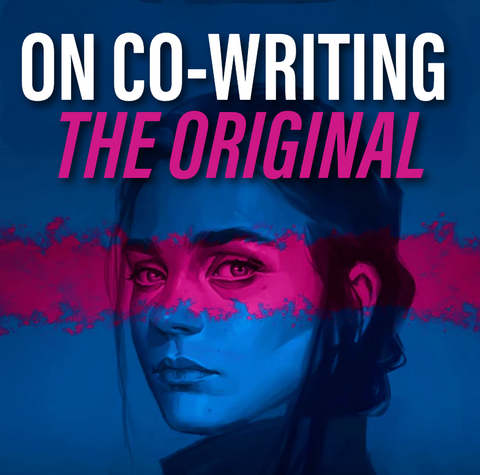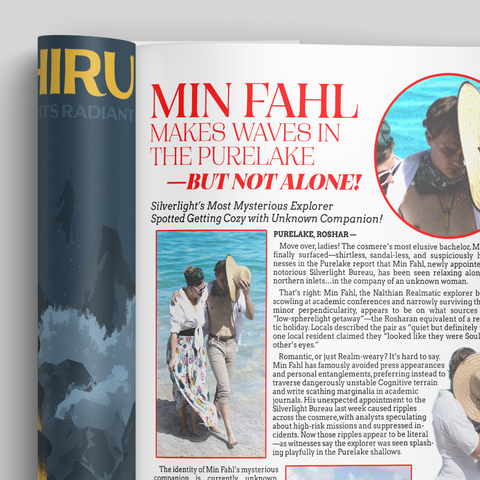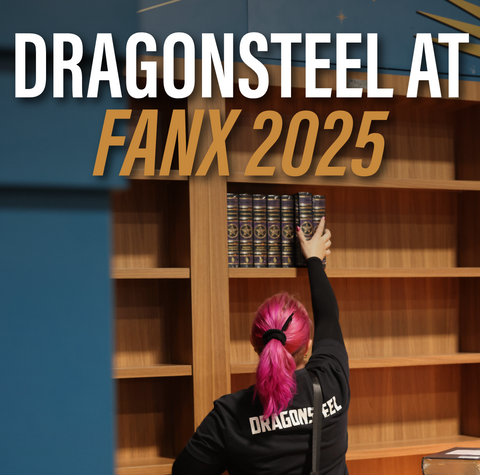Have you ever wondered what would happen if you had to hunt down your own clone? If so, you should check out The Original, an audio-first sci-fi thriller that Mary Robinette Kowal and Brandon Sanderson created in 2020. Now, finally, you can read it too!
For years, this near-future tale of identity, murder, and survival existed only as an audiobook. But with the recent ebook release, I had to revisit this thought-provoking world. The wonderful Mary Robinette met up with me to dive into what made this project so special, and why her background as a professional puppeteer might just be her secret writing weapon (and maybe yours too).
Teaming Up on The Original
The idea for The Original began with Sanderson. “It came out of Brandon’s brain—he’d been kicking it around for a bit,” Kowal says of the story’s origin. When Sanderson approached her with the concept, Kowal was immediately on board. “Collaborating with Brandon was natural because of Writing Excuses,” Kowal noted, referring to the award-winning writing craft show they’ve worked on together in the past..
One of my favorite details to come out of our conversation was that this was a particularly enlightening drafting process, because Sanderson hadn’t realized how much worldbuilding he does on the fly during drafting. “Brandon said that he had not realized until doing this project how much of his worldbuilding he does in his writing,” Kowal recalls. This created some useful creative friction during the drafting process where Kowal would go through Sanderson’s notes and realize that one of the elements either didn’t make sense or needed further ironing. So, they’d hop on a phone call to work it out.
Something I was curious about was if they had always planned for this to be an audio-first experience or if that emerged in the drafting process. But, Kowal says the format was clear from the beginning: “[Sanderson] knew he wanted to do it for audio from the beginning,” she said.
Writing for Your Ears, Not Your Eyes
Here's where things get really interesting. With the goal of writing for an audio-first experience in mind, Kowal set out to make the text itself as helpful as possible to a narrator (she herself is an award-winning narrator, lending an insider’s perspective to the process).
“Because I also narrate, I know there's a space you can bring to a narrator that can make things feel more naturalistic,” she explains. “Take something as simple as the word “what.” In conversation, that single word can convey confusion, anger, disbelief, or sarcasm just through tone.”
Kowal became a director on the page, inserting stage directions in brackets throughout the manuscript. A character might be [sarcastic] or [shouting], giving the narrator clear emotional cues. It was kind of like writing a script disguised as a novel, which as a performer came naturally to Kowal.
The final production, narrated by Julia Whelan, went full cinematic with sound effects and background music. In one club scene, you can hear the thrum of futuristic dance music. “There's a cadence you can bring to an audio narrative that makes it more intimate,” Kowal notes, and the result feels like something inventive—something between an audiobook and an audio drama.
Two Hollys Walk Into a Bar...
The story's central premise will delight sci-fi fans (especially those, like Sanderson himself, who love a good cloning narrative): Holly Winseed wakes up as a government-made clone tasked with hunting down her original self, who's on the run for murder. I wondered if writing two versions of the same character would be a nightmare, but Kowal found it surprisingly natural.
“One of the things I'm aware of with myself is that I'm not the same person I was a decade ago,” she reflects. "There are things I used to think that were problematic, and I know better now. So, in a way, I can relate to the idea of being two different versions of myself, which is how I went about writing this story.” The two Hollys share core memories but diverge based on their different experiences since the split.
Kowal's trick? Attitude. "When you're creating a narrative voice for a character, you have a tool called attitude," she explains. "You know how you can tell someone is on the phone and smiling?" By the story's end, listeners can identify which Holly is speaking not just from context, but from subtle differences in how she reacts and speaks.
The Puppeteer's Secret
Beyond writing and narrating, Kowal is a professional puppeteer. Those skills translate to the page in ways you'd never expect.
"A lot of the way the puppetry comes through is in the way I handle body language," she says, explaining her "four principles of puppetry": focus, breath, muscle, and meaningful movement.
Focus determines what a character is thinking about. Breath indicates emotion: "How long you linger is tied to your emotions… lingering out of a sense of dread or anticipation. You can control that on the page literally by how many words you're using." Muscle maps to internal motivation, while meaningful movement ensures every gesture serves a purpose.
The result is scenes that breathe with life instead of feeling like talking heads. Whether it's a trembling hand or a door slammed in anger, Kowal choreographs her characters' physicality like a puppet show—deliberately and meaningfully.
On Co-Writing
For writers considering collaboration, Kowal’s advice is straightforward. "Really, it is to play to your strengths," she emphasizes. "Sit down and have an honest conversation with each other about the [parts of writing] that bring you joy, the things that cause you to shut down, the things that make you excited and wanting to keep going. Trust those strengths! Don't try to bury them."
It's refreshingly practical advice. If one writer loves worldbuilding and the other thrives on snappy dialogue, lean into those preferences. If revisions drain one person, let the other take the editing lead. The goal is keeping both collaborators energized and engaged.
What's Next: Hitchcock in Space
This October, Kowal is diving into another format experiment with Apprehension, published as part of a "Saga Double." She describes it as an homage to those old Ace Double paperbacks where you flip the book over to read the second story.
"Hitchcock in space," she says enthusiastically of her story for the book, which involves kidnapping and mistaken identities on an alien planet. It's paired with Sam J. Miller's Red Star Hustle.
From audio-first collaborations to throwback double novels, Kowal keeps pushing boundaries in speculative fiction. Her willingness to experiment is inspiring, and The Original proves that when creative minds experiment together in just the right way, you get some really incredible stories.




Comments (0)
There are no comments for this article. Be the first one to leave a message!